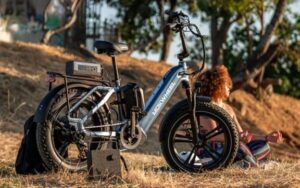Fat-tire electric bikes have become increasingly popular among outdoor riders and daily commuters thanks to their strong off-road capability, comfort, and adaptability across multiple terrains. Among all components, the one that affects the riding experience the most is the battery.
This guide uses industry data and real-world usage scenarios to explain how long fat-tire electric bike batteries last, why they degrade, and what you can do to keep them healthier for much longer.
How Long Do Fat-Tire Electric Bike Batteries Last?
Most fat-tire electric bikes are equipped with lithium-ion batteries. Their lifespan is typically measured in charge cycles. On average, they last three to five years, supporting about 500–1,000 full charge cycles.
Why do fat-tire models have slightly shorter battery lifespans?
Because fat-tire electric bikes usually have:
- Wider tires → higher rolling resistance
- Heavier overall weight
- More off-road, uphill, and heavy-load usage
These factors require higher power output, generate more heat, and lead to faster battery degradation.
This is why fat-tire riders need to pay extra attention to battery care and usage habits.
Key Factors That Affect Battery Lifespan
Temperature (the most critical factor)
High temperatures accelerate chemical aging. Low temperatures reduce discharge performance and noticeably decrease range.
The ideal operating temperature for modern lithium batteries is 41–86°F (5–30°C).
Charging & Storage Habits
Incorrect charging habits can significantly shorten battery life, such as:
- Keeping the battery at 100% for long periods
- Using poor-quality chargers
- Frequently draining the battery down to 0%
Correct practices include:
- Keep the battery at 30%–60% for long-term storage
- Avoid both extreme heat and freezing environments
Riding Conditions
Fat-tire bikes often run on sand, forest trails, snow, and steep hills—terrains that keep the motor under high load, which accelerates battery cycle consumption.
Rider Load & Tire Pressure
Extra weight and low tire pressure increase motor strain, causing faster battery wear.
How to Extend the Battery Life of a Fat-Tire Electric Bike
Here are the most practical tips tailored for fat-tire models:
Keep Charging Between 20%–80% (Optimal Range)
Even with modern BMS protection, storing the battery at full charge or allowing it to run too low can speed up aging.
Recommended:
- Daily use: charge to 80–90%
- Avoid riding until automatic shutdown
Avoid High-Temperature Exposure
Never leave the battery on the bike under the summer sun
In winter, bring the battery indoors to warm up before charging
Extreme temperatures are the #1 enemy of battery lifespan.
Use Lower Assist Levels When Possible (Especially Important for Fat Tires)
The wider tires create more resistance. Prolonged high-assist or full-throttle riding causes high discharge rates that strain the battery.
On flat roads → use lower PAS levels
Uphills → assist with pedaling; avoid rapid throttle bursts
Maintain Proper Tire Pressure & Reduce Extra Load
Fat-tire pressure is often overlooked. Low PSI dramatically increases energy consumption.
Recommended tire pressure:
- Pavement: 12–18 PSI
- Off-road: 8–12 PSI (adjust based on terrain)
Best Storage Practices for Long Periods of Non-Use
Keep the battery at 30–60% charge, top it up every 2–3 months, and store it in a cool, dry place.
Stress-Reduction” Tips for Your Battery
Small habits that make a big difference:
- Avoid long periods of full-load riding
- Keep battery terminals clean
Use the original charger or a high-quality certified charger

Five Signs Your Battery Is Reaching the End of Its Life
Replace the battery if you notice:
- Range drops to 60%–70% of the original
- Voltage sag or rapid power loss (especially in cold weather)
- Charging finishes much faster than before
- Significant self-discharge after a few days of storage
- Sudden power cut-offs while riding
These are signs of severe capacity degradation.
How Does Mokwheel Perform in Battery Longevity?
Among many fat-tire electric bike brands, Mokwheel has gained attention in recent years due to its highly stable battery systems and stricter battery management standards.
Since fat-tire users often face more demanding terrains, Mokwheel designs its bikes with:
- Higher-capacity batteries
- Better heat dissipation systems
- Optimized battery management (BMS)
This allows their bikes to maintain stable output during long, high-load rides. Riders who value range and long-term durability benefit significantly. Mokwheel’s optimized BMS also helps slow battery degradation even under multi-terrain, long-distance, or frequent-climbing conditions—making it an excellent choice for performance-focused fat-tire riders.
Can Fat-Tire Electric Bike Batteries Last Longer?
Absolutely—yes.
With proper daily habits like controlled charging, avoiding extreme heat, using appropriate assist levels, maintaining tire pressure, and storing the battery properly, fat-tire electric bike batteries can easily last three to five years or even longer while maintaining good range performance.
Since the battery is always the core component influencing ride quality, taking good care of it ensures safer, more stable, and more enjoyable rides. As electric bike technology continues to improve, battery durability is also getting better year after year.
With proper use and maintenance, your fat-tire electric bike can deliver reliable performance for years to come—whether for commuting, outdoor adventures, or weekend exploration.
Frequently Asked Questions
Does charging every day damage the battery?
No. Lithium batteries are not harmed by frequent top-ups. Daily charging is fine as long as you don’t let the battery drop too low or store it at 100% for long periods. Partial charges are healthier than deep discharges.
Why does my battery lose so much range in winter?
Cold temperatures reduce chemical activity inside lithium batteries, lowering discharge efficiency. All lithium batteries behave this way. Once the temperature warms up, range typically returns to normal.
Can I replace the battery myself when it wears out?
Most fat-tire electric bike batteries are replaceable. However, you must use a battery that matches your bike’s:
- Voltage
- Capacity
- Dimensions
- Connector type
If you’re not familiar with electrical systems, have a technician replace it to avoid safety risks.
Can I use a fast charger? Will it harm the battery?
Fast chargers shorten charging time but put more stress on battery cells, accelerating long-term aging. Unless absolutely necessary, stick to the original or standard charger to keep the battery healthier.
How can I tell if my battery is aging?
Signs include noticeably reduced range, faster-than-normal charging, significant power loss during storage, and sudden power shut-offs while riding, so if you experience any of these, have the battery inspected or replaced.
Do lithium batteries require special maintenance?
No complicated maintenance is needed—just keep the case and terminals clean, avoid extreme temperatures and frequent deep discharges, and for long-term storage maintain 30–60% charge and top it up every 2–3 months.
How can I extend my riding range?
Maintain proper tire pressure, reduce unnecessary weight, use reasonable assist levels, avoid prolonged high-speed riding, and accelerate smoothly while adjusting to the terrain—all of which help improve efficiency and extend your range.






